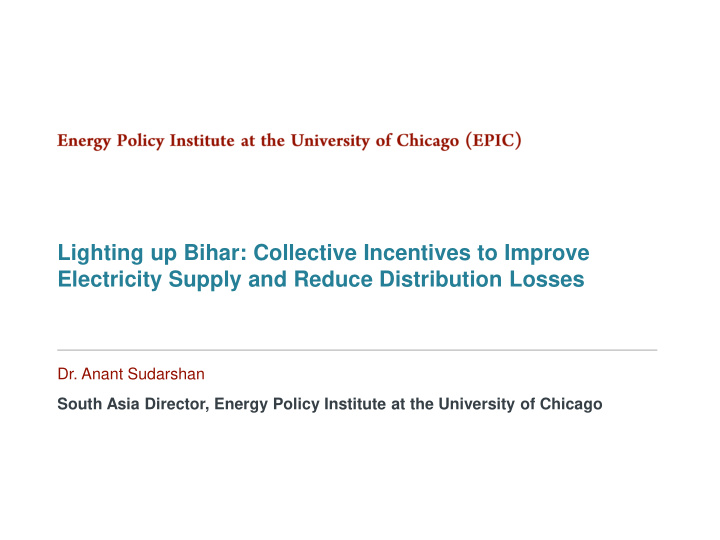



Lighting up Bihar: Collective Incentives to Improve Electricity Supply and Reduce Distribution Losses Dr. Anant Sudarshan South Asia Director, Energy Policy Institute at the University of Chicago
India has made amazing progress in improving electricity access Data from 2014
India has made amazing progress in improving electricity access Data from 2017
But electricity quality remains a major challenge… • Notwithstanding near 100 percent connections load-shedding and power outages remain endemic • Utility losses have fallen but remain high • In 2014, 42 percent of power injected into the distribution grid was “lost” • In 2019, 27 percent of power fetches no revenue This doesn’t include subsidies, which cost the state money • • Poor supply quality may eliminate most of the benefits of electrification for some sectors • Cannot undertake many mechanized activities with unreliable power • Cannot stock goods requiring cold storage with unreliable power • Etc etc
The Revenue Linked Supply Scheme • This project was a partnership with the electricity distribution companies in Bihar, a state of over 100 million people Champaran W Champaran E Sitamarhi • Sheohar Gopalganj Bihar lagged much of Madhubani Kishanganj Supaul Araria Siwan Muzaffarpur India after independence, Darbhanga Saran Madhepura Saharsa Purnea but lately has invested in Samastipur Vaishali Katihar Khagaria Begusarai law and order, Buxar Ara Patna Bhagalpur Nalanda Munger infrastructure, education, Jehanabad Lakhisarai Shekhpura Kaimur Rohtas and electricity access Banka Nawada Aurangabad Jamui Gaya and seen a large return in growth (~10%/year) • This project was executed as a randomized control trial
No relationship between electricity supply and payment 24 20 Hours of Electricity Per Day 16 12 8 4 0 0 .1 .2 .3 .4 .5 .6 .7 .8 .9 1 Revenue Rate (0-1)
Goal: Minimize losses through improved rationing of power supply • Ration better: supply more power to areas that pay more • Explicitly recognize that non-payment is a collective action problem • Try to change social norms about payment • Override low-level collusion and collective problems • Best case: multiple equilibria, including high-payment high-quality, which can be reached by a “big push”
Treatment: 1. Partition on payment Hours of Electricity Per Day 0 4 8 12 16 20 24 0 .1 Bin 1 Cutoff: 15% .2 Bin 2 Cutoff: 30% .3 Revenue Rate (0-1) .4 Bin 3 Cutoff: 45% .5 Bin 4 Cutoff: 60% .6 .7 .8 .9 Bin 5: >60% 1
Treatment: 2. Link hours to bin Assigned Supply Hours for Treatment 0 4 8 12 16 20 24 0 .1 Bin 1 Cutoff: 15% .2 Bin 2 Cutoff: 30% .3 Revenue Rate (0-1) .4 Bin 3 Cutoff: 45% .5 Bin 4 Cutoff: 60% .6 .7 .8 .9 Bin 5: >60% 1
Treatment: 3. Control hours flat Assigned Supply Hours for Treatment & Control 0 4 8 12 16 20 24 0 .1 Bin 1 Cutoff: 15% .2 Bin 2 Cutoff: 30% .3 bf:Revenue Rate (0-1) .4 Bin 3 Cutoff: 45% .5 Bin 4 Cutoff: 60% .6 .7 .8 .9 Bin 5: >60% 1
Marketing: Bill inserts with monthly bills Pay bills on time, get high electricity supply. Electricity has become our pride, we will do bill payment on time. Households will have lighting if everyone pays their bills together.
Marketing: Posters around villages Pay bills on time, get high electricity supply. People of my area paid their electricity bills on time, leading to more supply here and helped me gain profits in my business.
Marketing: Public announcements Pay bills on time, get high electricity supply. Stop power theft in your area to increase power supply in your homes. Call the toll-free number 1 800 345-6198 for assistance and complaints.
Revenues in treatment feeders increased
North Bihar feeders particularly responsive Revenues Increased Energy Use Increased Data from North Bihar Power Distribution Company Ltd.
But average propensity to pay did not change
Recommend
More recommend